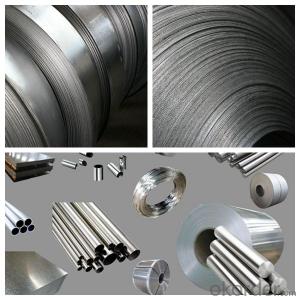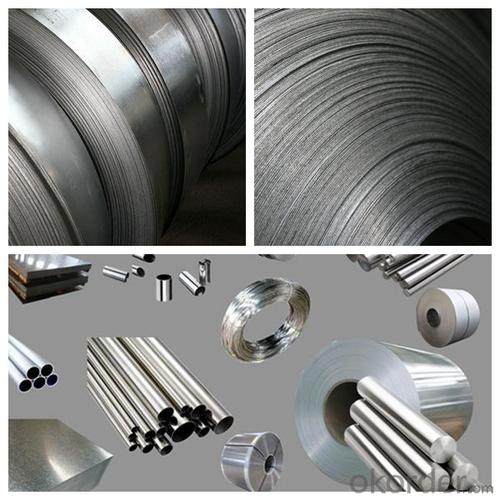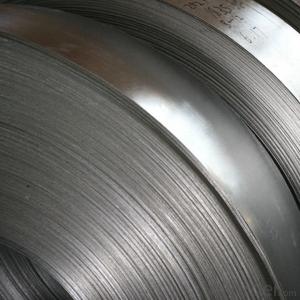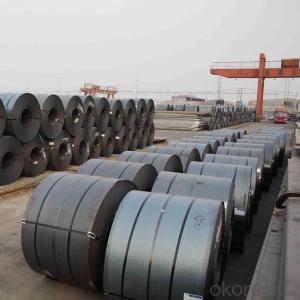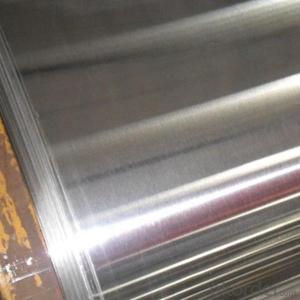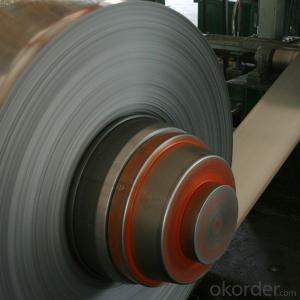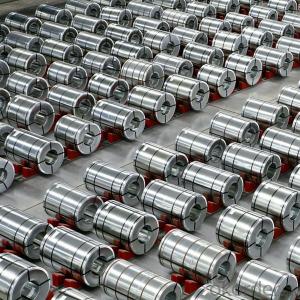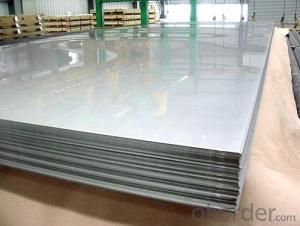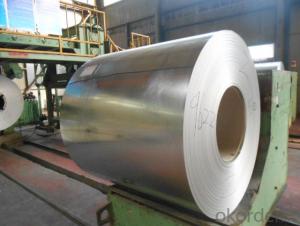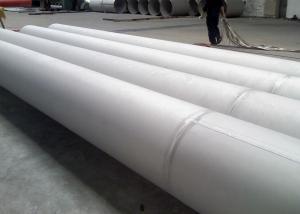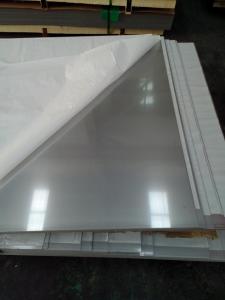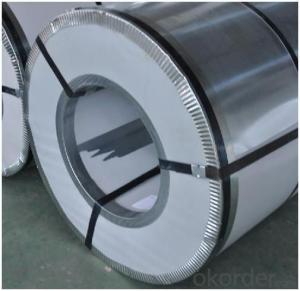Hot Rolled Stainless Steel 304 NO.1 Made in China
- Loading Port:
- China main port
- Payment Terms:
- TT OR LC
- Min Order Qty:
- 100000 m.t.
- Supply Capability:
- 100000 m.t./month
OKorder Service Pledge
OKorder Financial Service
You Might Also Like
Specification
Products Description
Name: stainless steel coils/plates/sheets
Discharge Port: Any Port, China
Cold Rolled Size: thickness0.3-8mm,Width:280-2100mm
Hot Rolled Size: Thickness3-14mm,Width:650-2100mm
Hot Rolled/Cold Rolled Plates : Thickness2-80mm,Width:1500-3000mm
Coil Weight: About 20 Tons
Grade: 201,202,304/304L/304H, 316/316L/316H, 409/L,430 etc.
Technique: Hot Rolled/Cold Rolled
Finish:2B, BA, 2D, No1, No2 etc
Edge: Mill Edge / Slitting Edge
Packaging: In bundles, or as customer's requirement
Place of Origin: Made in China
MOQ: 20 Tons
Payment Terms: 100% LC at sight, or 100%TT in advance
Delivery Time: With 30-40 days after deposit
Features of Stainless Steel Coils
(1) Good ductility
(2) Good corrosion resistance
(3) Excellent abrasion resistance and fatigue strength
(4) Good weldability
(5) Oxidation resistant performance
(6) Excellent in high temperature
Packaging & Delivery
Packaging Detail Standard export packing or following customer's demand
Delivery Time: Within 30-40 days after deposit or according to the order quantity
Application of Stainless Steel Coils
(1) Boiler heat exchanger,
(2) Chemical industries,
(3) Hardware fields,
(4) Construction material,
(5) Kitchen utensils,
(6) Building construction,
(7) Medical equipment,
(8) chemical tank,
(9) pipe etc
Payment&Delivery
Payment Terms | 100% LC at sight,or 30%TT in advance, balance against B/L copy |
Delivery Time | With 30-40 days after deposit |
Price Terms | Ex-Work, FOB, CNF, CFR, CIF,etc |
Detail picture of Products:
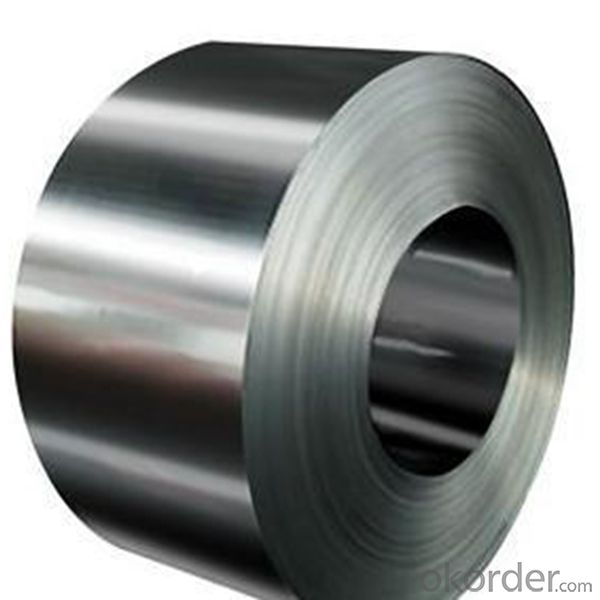

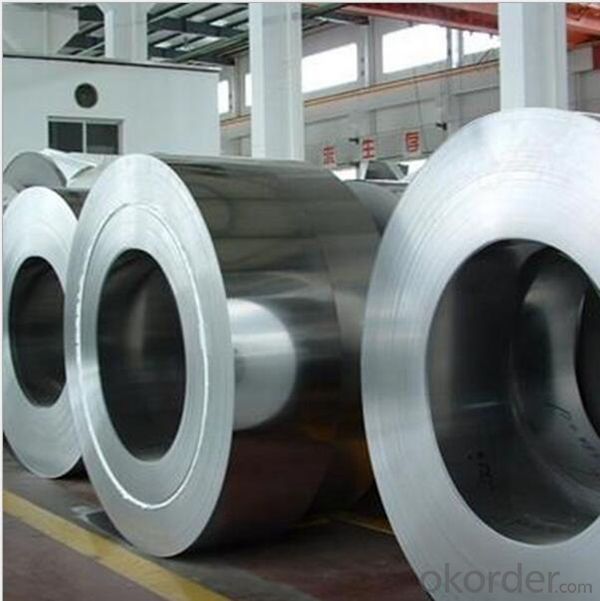
Export Markets
Our target market is the international market. Every year we export most of products to countries like India, Pakistan, South Korea, Brazil, Australia, South Africa, Spain, Sri Lanka, Taiwan, Hong Kong, etc.
FAQ
Q: How long is the delivery time?
A: Normally 30-40 days, but mostly according to the specific requirements or the quantity
Q: Could you send me sample?
A: We can supply you with the sample for free, but the delivery charges will be covered by customers.
- Q: What is the elongation of stainless steel sheets?
- When stainless steel sheets are subjected to tensile forces, their ability to stretch or deform without breaking is known as elongation. This property is measured as a percentage of the original length of the sheet that can be stretched before it fractures. The elongation of stainless steel sheets can vary depending on the grade of stainless steel and the way it is manufactured. In general, stainless steel sheets have a higher elongation compared to metals like carbon steel because they are more ductile. However, the specific elongation value can vary based on factors such as the grade, thickness, and tempering of the stainless steel sheet.
- Q: What are the standard sizes of stainless steel sheets?
- The standard sizes of stainless steel sheets vary depending on the specific industry and application. However, there are some commonly used standard sizes that are widely available. In the architectural and construction industry, the standard sizes of stainless steel sheets typically range from 4 feet by 8 feet (1220mm x 2440mm) to 5 feet by 10 feet (1524mm x 3048mm). These sizes are commonly used for cladding, roofing, and interior design applications. In the manufacturing and industrial sectors, stainless steel sheets come in various sizes, including 4 feet by 8 feet, 4 feet by 10 feet (1220mm x 3050mm), and even larger sizes like 5 feet by 12 feet (1524mm x 3658mm). These larger sizes are often used for fabrication, industrial machinery, and equipment manufacturing. It's important to note that custom sizes can also be fabricated based on specific project requirements. These custom sizes may include narrower or wider widths, longer or shorter lengths, or even different thicknesses to meet the needs of a particular application. Ultimately, the standard sizes of stainless steel sheets are determined by industry standards, market demand, and the capabilities of the manufacturers. It's always advisable to consult with suppliers or manufacturers to ensure the availability of the desired size before making a purchase.
- Q: What are stainless steel sheets used for?
- Stainless steel sheets serve a multitude of purposes in diverse industries. Their outstanding resistance to corrosion, durability, and attractive appearance make them highly sought after in both commercial and residential settings. Within the construction field, these sheets are utilized for roofing, cladding, and facades due to their ability to withstand harsh environmental conditions while providing a contemporary and sleek look. In the automotive industry, they are frequently employed in the construction of car bodies, exhaust systems, and decorative trims. Furthermore, stainless steel sheets find extensive use in the food and beverage sector, where their hygienic qualities make them ideal for kitchen equipment, countertops, and food processing machinery. Additionally, they are widely used in medical equipment, pharmaceuticals, and laboratory settings due to their resistance to corrosion and ease of cleaning. They are also employed in furniture, appliances, signage, and for decorative purposes, as they can be easily customized and molded into various shapes and sizes. All in all, stainless steel sheets are an adaptable material that fulfills a diverse array of requirements in different industries, owing to their strength, durability, and corrosion resistance properties.
- Q: Why do galvanized and stainless steel sheets buy more expensive than thin ones?
- Effects: galvanized steel sheet is to prevent corrosion of steel plate surface and prolong its service life, and the surface of steel plate is coated with a layer of metal zinc. This kind of zinc coated steel plate is called galvanized sheet.
- Q: 430 stainless steel plate maximum temperature tolerance is how many degrees?
- All the properties of 430 stainless steel with 430 stainless steel, with good corrosion resistance and better thermal conductivity than austenitic steels, thermal expansion coefficient smaller than the austenitic thermal fatigue, adding stabilizing elements of titanium, parts of the mechanical properties of the welded seam, mainly used for building decoration, household appliances, fuel burner parts, home appliance parts.
- Q: What is the tensile strength of stainless steel sheets?
- The tensile strength of stainless steel sheets can vary depending on the specific grade and thickness of the material. Generally, stainless steel sheets exhibit a higher tensile strength in comparison to other materials. For instance, stainless steel sheets like the commonly used 304 and 316 grades typically possess tensile strengths ranging from 515 to 690 megapascals (MPa) or 74,800 to 100,000 pounds per square inch (psi). However, it is crucial to note that the tensile strength values may differ for various grades and thicknesses of stainless steel sheets. It is always advisable to seek precise information regarding the tensile strength of specific stainless steel sheets from the manufacturer or supplier.
- Q: What are the different types of edge finishes available for stainless steel sheets?
- There are several different types of edge finishes available for stainless steel sheets. These finishes are applied to the edges of the sheets to provide a clean and polished appearance, as well as to protect against sharp edges and potential corrosion. 1. Mill Finish: This is the standard edge finish for stainless steel sheets. It is the raw, untreated edge that is produced during the manufacturing process. While it may have a slightly rough or uneven appearance, it is still functional and commonly used for industrial applications. 2. Deburred Edges: In order to remove any sharp or jagged edges, the stainless steel sheet can be deburred. This is done by grinding or sanding down the edges to create a smoother and safer finish. Deburred edges are commonly used in applications where safety is a concern, such as in food processing or medical equipment. 3. Rounded Edges: Rounded edges are created by using a rounding tool to smooth out the sharp corners of the stainless steel sheet. This type of edge finish not only enhances the aesthetics of the sheet, but also reduces the risk of injury from sharp edges. Rounded edges are often preferred for architectural or decorative applications. 4. Beveled Edges: Beveled edges are achieved by cutting or grinding the edge of the stainless steel sheet at a specific angle, typically 45 degrees. This creates a chamfered edge that adds a sleek and modern look to the sheet. Beveled edges are commonly used in applications where aesthetics and design are important, such as in furniture or interior design. 5. Polished Edges: Polished edges involve buffing or polishing the edge of the stainless steel sheet to create a smooth and mirror-like finish. This type of edge finish adds a touch of elegance and sophistication to the sheet, making it suitable for high-end architectural or decorative applications. In summary, the different types of edge finishes available for stainless steel sheets include mill finish, deburred edges, rounded edges, beveled edges, and polished edges. Each finish offers its own unique benefits and is chosen based on the specific requirements of the application.
- Q: Are stainless steel sheets suitable for roofing?
- Yes, stainless steel sheets are suitable for roofing. They have excellent durability, corrosion resistance, and can withstand extreme weather conditions. Additionally, their sleek appearance adds aesthetic value to any building.
- Q: Can stainless steel sheets be used for elevator cladding?
- Yes, stainless steel sheets can be used for elevator cladding. Stainless steel is a popular choice for elevator cladding due to its durability, aesthetic appeal, and resistance to corrosion and staining. It provides a sleek and modern look while also offering protection against wear and tear in high-traffic areas.
- Q: How do I determine the flatness of stainless steel sheets?
- To determine the flatness of stainless steel sheets, you can use various methods such as visual inspection, measuring with a straight edge or ruler, or utilizing specialized tools like a flatness gauge or a laser level. Visual inspection involves observing the surface for any visible curvature or warping. Measuring with a straight edge or ruler can help identify any gaps or deviations from a flat surface. Specialized tools like a flatness gauge or a laser level provide more precise measurements by quantifying the degree of flatness.
Send your message to us
Hot Rolled Stainless Steel 304 NO.1 Made in China
- Loading Port:
- China main port
- Payment Terms:
- TT OR LC
- Min Order Qty:
- 100000 m.t.
- Supply Capability:
- 100000 m.t./month
OKorder Service Pledge
OKorder Financial Service
Similar products
Hot products
Hot Searches
Related keywords
